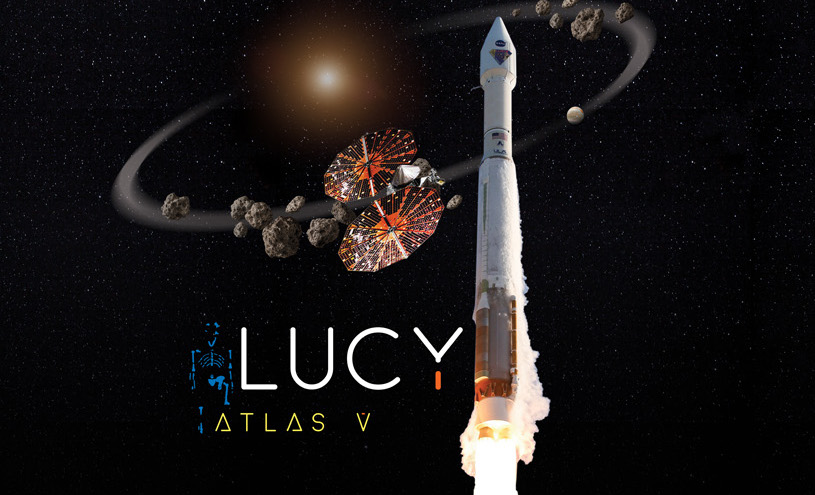
NASA and United Launch Alliance officials met Wednesday and cleared an Atlas 5 rocket for launch from Cape Canaveral before dawn Saturday with the Lucy asteroid mission, a robotic spacecraft to visit unexplored asteroids in the outer solar system.
Managers gave a “go” to continue rocket preparations during a launch readiness review Wednesday, giving a green light for teams to press on with rollout of the 188-foot-tall (57.3-meter) Atlas 5 rocket to its launch pad Thursday morning.
The rocket will make the 1,800-foot (550-meter) journey from ULA’s Vertical Integration Facility to the Complex 41 launch pad Thursday at 10 a.m. EDT (1400 GMT) to begin final pre-flight preparations.
The Atlas 5 will make the trip on top of a mobile launch platform pushed by locomotives along rail tracks leading to the launch pad. The transfer should take less than an hour to complete.
Once the rocket and its mobile platform are at pad 41, teams will connect auto-couplers to feed cryogenic propellant into the Atlas 5 during the countdown Saturday morning.
The 75-minute launch window for the Lucy mission opens at 5:34 a.m. EDT (0934 GMT). ULA has launch opportunities available at five minute intervals throughout the window, each with a unique trajectory utilizing the Atlas 5’s yaw steering ability to deploy the Lucy spacecraft on the proper path into the solar system.
“We look forward to a beautiful launch Saturday,” said Omar Baez, NASA’s launch director for the Lucy mission.
The weather forecast looks favorable for liftoff Saturday, with a 90% chance of acceptable conditions for the Atlas 5 to blast off from Cape Canaveral Space Force Station.
“We can see a nice area over the entire Southeast U.S. that’s mainly cloud free, and that’s due to high pressure dominating the area,” said Jessica Williams, launch weather officer from the U.S. Space Force’s 45th Weather Squadron. “That area of high pressure will actually slide southward right over Central Florida for Saturday morning, giving us a beautiful morning for launch.”
The weather team predicts mostly clear skies Saturday morning, with light westerly winds, and a temperature between 74 and 76 degrees Fahrenheit. The only slight weather concern is a small chance of a violation of the cumulus cloud rule.
A cool front is expected to move through Central Florida on Sunday, bringing more clouds, moisture, and stronger winds to the area. There’s a 50% chance of acceptable weather for liftoff Sunday morning, when the launch window again opens at 5:34 a.m. EDT.
The $981 million Lucy asteroid mission has a 23-day launch window to depart Earth this year. If the mission isn’t off the ground by Nov. 7, NASA has a backup launch period available next October for Lucy to take off and still visit its eight asteroid targets.
“We’ve had the opportunity to partner with NASA and launch spacecraft to explore all of the planets of the solar system,” said John Elbon, ULA’s chief operating officer. “It really gets the team excited to be a part of this. It’s a big deal. Interplanetary missions are particularly challenging because the launch windows are short.”
During its 12-year mission, Lucy will fly by eight asteroids, including seven objects located in the so-called Trojan swarms ahead of and behind Jupiter in its orbit around the sun. The Trojan asteroid flybys will begin in 2027 and end in 2033.
Scientists believe the Trojan asteroids are leftover building blocks from the formation of the giant planets in the outer solar system. Learning more about the Trojan asteroids, which have never been visited before, could provide insights into the solar system’s evolution.
Ground crews mounted the 3,300-pound (1,500-kilogram) Lucy spacecraft on top of ULA’s Atlas 5 rocket Oct. 7. Since then, teams completed an integrated systems test to verify electrical connections between the Lucy spacecraft and the Atlas 5 launcher.
NASA and ULA participated in a mission dress rehearsal Tuesday, setting the stage for the launch readiness review Wednesday, and rollout to the launch pad Thursday.
The launch team will get a rest day for most of Friday before reporting to the control center for the start of the countdown at 10:14 p.m. EDT (0214 GMT Saturday).
ULA and switch on the Atlas 5 rocket’s computers and complete preliminary checkouts before beginning the load of cryogenic liquid hydrogen and liquid oxygen into the first stage and Centaur upper stage.
The hydrogen and oxygen will feed the Centaur upper stage’s RL10 engine for two burns during Lucy’s launch. The two firings will first place the Lucy spacecraft into orbit around Earth, then add speed for Lucy to escape the planet’s gravitational grasp and head into the solar system.
The Atlas 5’s Russian-made RD-180 first stage engine will consume liquid oxygen in combination with kerosene fuel. The kerosene fuel, which is stored at room temperature, was loaded into the first stage during a countdown rehearsal earlier this month.
Email the author.
Follow Stephen Clark on Twitter: @StephenClark1.
